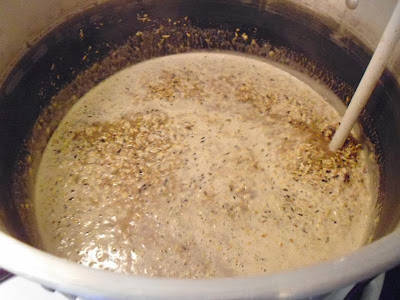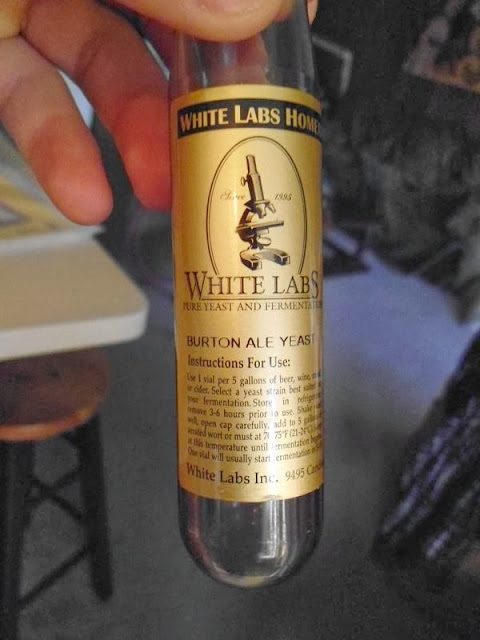We're back in action. I had to bang on some pots and pans to wake everyone up today. This time we're making an English brown ale to test our
new mash/lauter tun setup. Additionally, we have purchased Star San, a concentrated solution of phosphoric acid, to sanitize our equipment. After the
infection of our last batch, we aren't taking any chances today.
 |
| Getting the kitchen clean and spotless |
 |
| Grain in our new bag |
The Bammforth Brown Ale
7.5 lbs 2 Row
0.5 lbs Brown Malt
0.5 lbs Roasted Barley
0.25 lbs Munich
0.25 lbs Crystal 40
1 oz Fuggles
1 oz Willamette
Burton Ale Yeast WLP023
 |
| Adding the grain directly to the mash |
Since we are abandoning the
brew-in-a-bag method, our mashing process slightly changes. We add our grain directly to the mash water in our brew kettle on the stove. It's almost the same as brew-in-a-bag, except without the bag and much less water.
 |
| This time we made porridge instead of tea |
We heated the mash water up to 65 degrees Celsius before adding in the grain. It was stirred while being added.
 |
| If you invent smell-o-vision through the internet, contact me and I'll make you rich |
Once all the grain was added, we brought the temperature back up to 65 (the grain absorbed some of the heat), turned the oven to simmer, and covered up the kettle.We left it like that for about 1 hour, periodically checking the temperature.
 |
| This ended up working |
As soon as the mash ended, water was moved from other pots on the stove to our sparge water bucket at the top of our lauter system. Since our brew kettle was being used for mashing, he logistical that we needed to solve was warming up 5 gallons of water with only a 2 gallon pot and a 1 gallon pot. Luckily, the water heated up quick enough before the sparge water ran out.
 |
| Vorlauf step 1 |
To begin lautering, we first vorlaufed the grain bed by draining the sweet wort and dumping it back into the lauter tun until no sediment remained.
 |
| Vorlauf step 2 |
Once vorlaufing was completed, we turned on spigot on and started the lautering (as seen in video below)
 |
| We built something that actually works |
 |
| Sparge arm was constructed from PVC fittings and a nylon barb (the same we used for the fermenters) |
 |
| Grain bed compacted after all sparge water ran out |
It took about 5.5 gallons of sparge water to bring out kettle up to the desired amount. From there, we moved onto the 1 hour boil, where we added in our 2 hop varieties.
 |
| Preboil volume |
 |
| Vigorous boiling |
Cooling only took about 30 minutes total, quicker than some of our other beers. I can attribute that to a bag of ice we found in the freezer.
 |
| Vigorous stirring action |
We made our starter the night before and I was impressed with how quickly fermentation started in the yeast starter. I read that this yeast can cause fermenters to blow up (in a great splash of beer) but I am hoping that won't happen.
 |
| 40 oz bottle yeast starter -- perfect reuse of container from the night before |
 |
| Using WLP023 -- Burton ale yeast |
The original gravity of our beer was
1.043. It should give around
4% ABV once finished. That's typical for this style, but we'll have to see whether or not it ferments as much as I think it will. Our mash efficiency was about 65%, which is better than before with brew-in-a-bag. We can probably get that number to be higher in future batches.
 |
| A nice foam after being oxygenated |
Moved to secondary fermentation 1 week later


















No comments:
Post a Comment
Hi folks, please only leave comments relative to the blog post. All spam will be removed and spammers will be blocked.
Note: Only a member of this blog may post a comment.